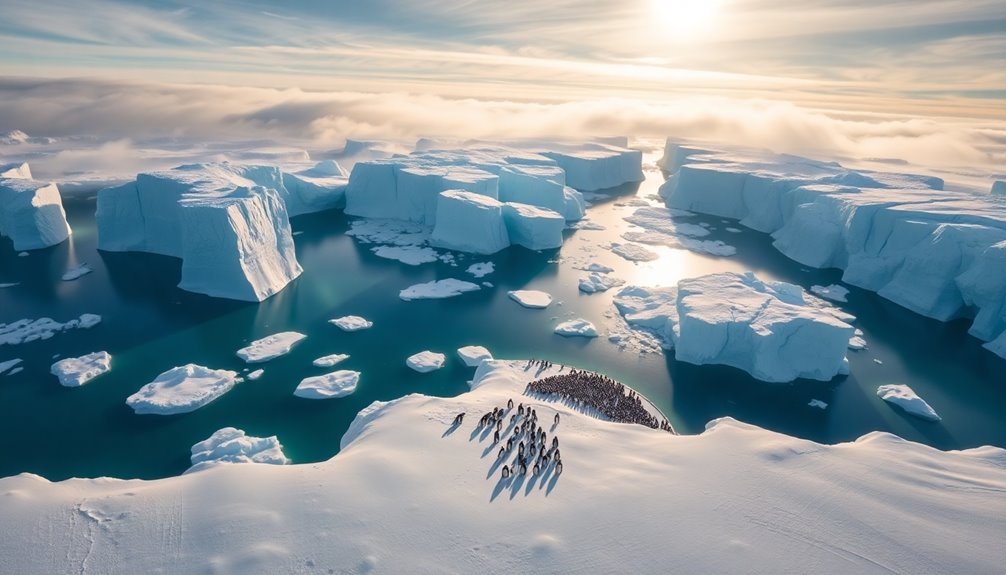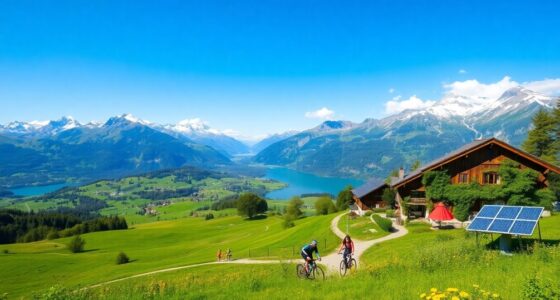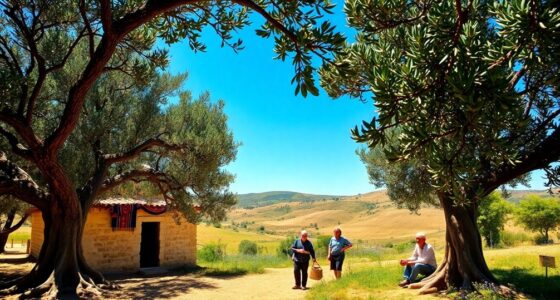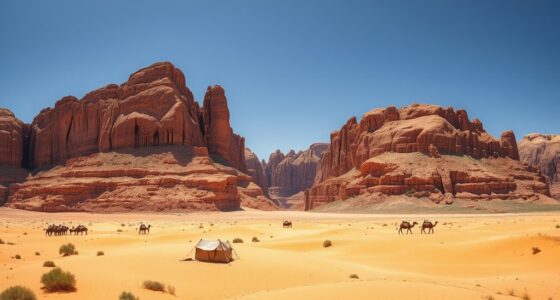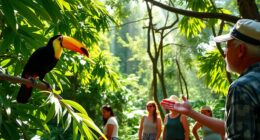Antarctica's untouched eco-wonders offer a unique adventure for sustainable travelers like you. As 98% of its land is covered in ice, you'll marvel at massive glaciers and pristine landscapes. To minimize your impact, choose eco-friendly airlines and accommodations, and consider carbon offset programs. Participate in wildlife photography workshops, where you can observe Emperor Penguins responsibly. Engage in community-led conservation projects to support local ecosystems. By following leave-no-trace principles and advocating for sustainability, you'll help preserve this pristine environment. There's so much more to explore about traveling sustainably in Antarctica that can enhance your journey significantly.
Key Takeaways
- Explore Antarctica's pristine icebergs and glaciers through sustainable activities like ice-climbing and glacier trekking to minimize environmental impact.
- Choose eco-friendly transport options, such as electric shuttles in Ushuaia, and select sustainable airlines to reduce carbon emissions.
- Participate in wildlife observation and photography workshops, adhering to ethical practices and IAATO guidelines to protect local ecosystems.
- Support local conservation projects during your visit by engaging in volunteer opportunities and donating to initiatives that promote biodiversity preservation.
- Offset your carbon emissions through verified programs that contribute to reforestation and renewable energy projects, fostering responsible tourism practices.
Introduction
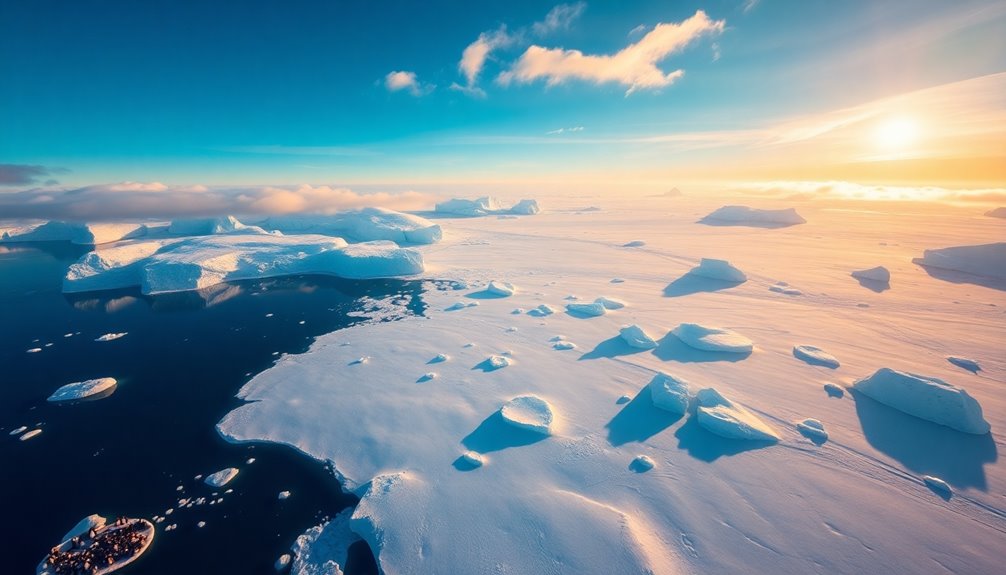
Antarctica's pristine glacial landscapes are breathtaking and full of wonder, waiting for you to explore.
However, protecting its unique ecosystems is essential, as they're incredibly fragile and vital to our planet.
Pristine Glacial Landscapes Await Exploration
As you step into the breathtaking realm of glacial landscapes, you'll find that Antarctica offers an unparalleled experience for explorers and nature enthusiasts alike. The continent's pristine beauty is showcased in its massive icebergs and ancient glaciers, covering about 98% of its surface.
You'll witness the dynamic natural processes of glacial movement, where ice flows and calving events create awe-inspiring sights. Engaging in ice-climbing and glacier trekking allows you to appreciate these fragile ecosystems up close.
However, it's vital to approach your adventure with sustainable practices in mind, minimizing your environmental impact. By respecting Antarctica's delicate habitats, you help preserve this untouched wonder for future generations while enjoying the unmatched splendor of this icy paradise.
Protecting Unique Antarctic Ecosystems
How can we ensure the preservation of Antarctica's unique ecosystems amidst growing threats? By adopting sustainable tourism practices, you can play a crucial role in protecting these delicate ecosystems.
The continent, home to 90% of the world's ice, supports diverse wildlife, including Emperor Penguins and seals. However, with tourism projected to reach 100,000 visitors annually, risks like habitat degradation and non-native species introduction increase.
You can help by following strict waste management guidelines and respecting wildlife interaction rules. Moreover, supporting collaborative efforts among tour operators and conservation organizations is essential.
Together, we can promote effective regulations that prioritize preserving Antarctica's fragile environments, ensuring future generations can enjoy its breathtaking beauty and vital ecological functions.
Travel From Ushuaia to Antarctica
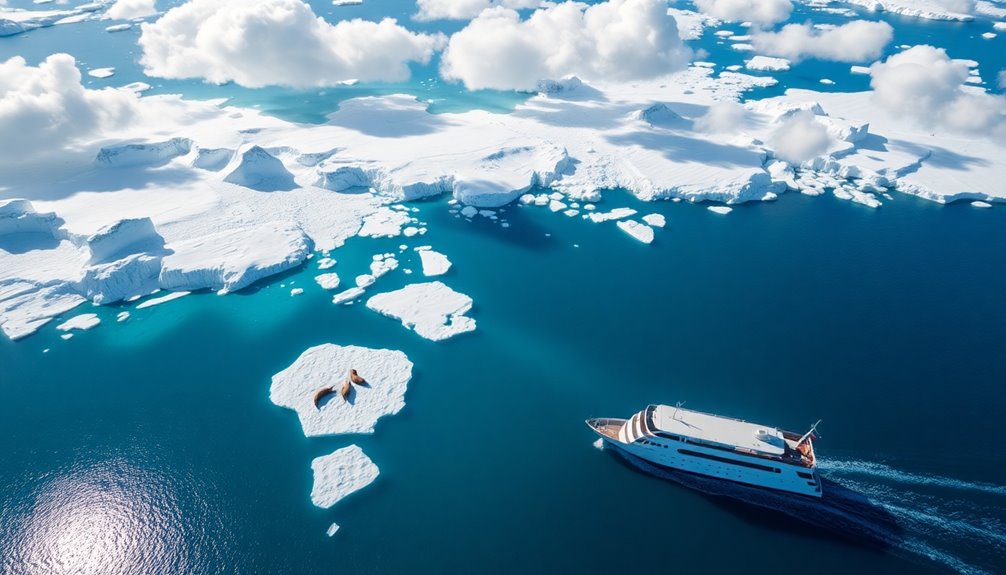
To reach the breathtaking landscapes of Antarctica, you'll first need to travel to Ushuaia, the southern tip of Argentina.
Whether you're flying from Miami, London, or Sydney, Ushuaia serves as your launchpad for this incredible adventure.
Once there, you can also enjoy eco-friendly electric shuttles that connect you to various research stations in the area.
Fly From Miami to Ushuaia
Flying from Miami to Ushuaia is the first step in your unforgettable journey to Antarctica. This long-haul flight, lasting about 8-10 hours, leads you to the southernmost city in the world, known as the gateway to Antarctica.
As you prepare for this adventure, remember the importance of conserving the environment and choose eco-friendly practices whenever possible.
- Opt for airlines that prioritize sustainability.
- Pack light to reduce your carbon footprint.
- Consider eco-friendly accommodations in Ushuaia.
- Engage in responsible tourism activities.
Your journey from Ushuaia to Antarctica not only promises stunning landscapes and wildlife but also supports efforts to preserve the delicate Antarctic ecosystem.
Travel From London to Ushuaia
Reaching Ushuaia is just the beginning of your Antarctic adventure, but first, you'll need to make your way from London. The journey typically involves a long-haul flight, which can significantly contribute to carbon emissions—averaging about 4.14 tons of CO2 per tourist. To minimize your impact, consider choosing eco-conscious airlines that adhere to responsible tourism practices.
| Journey Segment | Carbon Emissions | Eco-Friendly Options |
|---|---|---|
| London to Ushuaia | ~4.14 tons CO2 | Non-fossil-fuel aviation |
| Ushuaia to Antarctica | Low (by cruise) | Wildlife viewing protocols |
| Waste management systems | ||
| Local eco-conscious tours |
Once you arrive in Ushuaia, you'll be ready to embark on your unique expedition to Antarctica!
Fly From Sydney to Ushuaia
How do you make the leap from Sydney to Ushuaia, the gateway to Antarctica? First, you'll need to fly from Sydney to Ushuaia, typically taking about 14 to 15 hours, often with a layover in Buenos Aires.
Once you arrive in Ushuaia, you're set to embark on an unforgettable adventure.
Here are a few tips for your journey:
- Choose eco-friendly operators for your expedition.
- Familiarize yourself with IAATO guidelines to minimize your impact.
- Keep an eye out for seabirds and marine life during the crossing.
- Respect the fragile Antarctic ecosystem and its wildlife.
- Consider your carbon footprint and explore options for renewable energy solutions to offset your travel emissions.
Your choices matter, ensuring that your travel doesn't negatively impact this pristine region.
Get ready for the adventure of a lifetime!
Electric Shuttles Around Research Stations
Electric shuttles are transforming the way you travel from Ushuaia to Antarctic research stations, offering a sustainable and efficient mode of transportation. By utilizing electric shuttles, you're reducing carbon emissions linked to traditional fuel-powered vehicles, making your journey more eco-friendly.
These shuttles align seamlessly with sustainable travel initiatives, ensuring that your trip helps protect Antarctica's pristine environment.
As part of a growing trend in eco-conscious tourism, the implementation of electric shuttles enhances your experience while adhering to strict sustainability practices.
This transition reflects broader efforts to harness renewable energy technologies within Antarctic operations, promoting a more responsible approach to both scientific research and tourism.
With electric shuttles, you're contributing to the preservation of this unique ecosystem.
Wildlife Photography Workshops
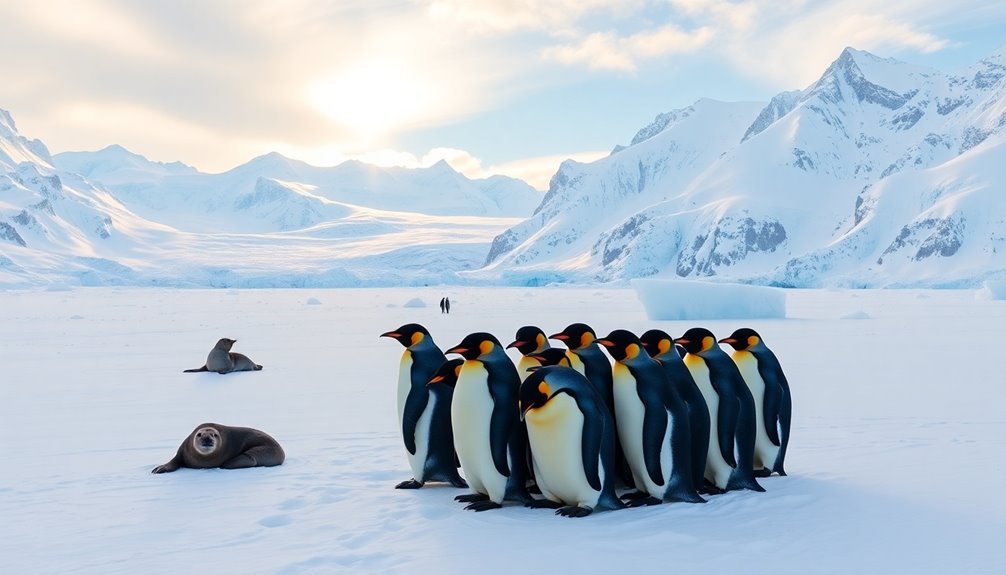
Joining a wildlife photography workshop in Antarctica gives you the chance to capture incredible moments while supporting conservation efforts.
You'll learn wildlife observation and tracking techniques from experienced guides, ensuring you respect the animals' natural behaviors.
Plus, many workshops offer sustainable lodging options, so you can enjoy your adventure while minimizing your environmental impact.
Wildlife Conservation Photography Workshops
Embarking on a wildlife conservation photography workshop in Antarctica offers a unique chance to capture breathtaking images while learning about the region's iconic species.
You'll enhance your photography skills with expert guidance and gain insight into ethical wildlife viewing practices.
- Capture stunning images of Emperor Penguins, seals, and whales
- Learn about the effects of climate change on delicate ecosystems
- Support local conservation initiatives through workshop proceeds
- Engage in environmentally responsible photography practices
These workshops are designed to minimize environmental impact, adhering to IAATO guidelines.
You'll also contribute to wildlife conservation efforts, fostering a deeper understanding of the importance of preserving Antarctica's unique biodiversity for future generations.
Join a workshop and make a positive impact while enjoying this pristine wilderness!
Wildlife Observation and Tracking
Wildlife observation and tracking in Antarctica amplifies the experience of photography workshops by allowing you to connect with the environment on a deeper level.
You'll have unique opportunities to capture images of iconic species like Emperor Penguins, seals, and seabirds in their natural habitats.
These workshops teach you techniques for ethical wildlife viewing, helping you maintain a safe distance while maximizing stunning photograph opportunities.
With expert guidance from wildlife photographers and biologists, you'll gain insights into Antarctic ecosystems and animal behaviors.
Emphasizing sustainable practices, these workshops ensure minimal impact on the environment and compliance with IAATO guidelines.
This immersive experience fosters a greater appreciation for conservation efforts, highlighting the importance of protecting these fragile ecosystems from climate change and human impact.
Sustainable Lodging Options Available
While exploring the breathtaking landscapes of Antarctica, you'll find a variety of sustainable lodging options designed to minimize environmental impact.
These eco-friendly lodges not only provide comfort but also emphasize low environmental footprints through innovative practices:
- Utilize sustainable building materials and energy-efficient technologies
- Feature solar-powered guest facilities, showcasing renewable energy sources
- Designed for seasonal dismantling, leaving no trace on the pristine landscape
- Offer wildlife photography workshops led by experienced photographers who prioritize ethical practices
Choose Carbon Offset Programs
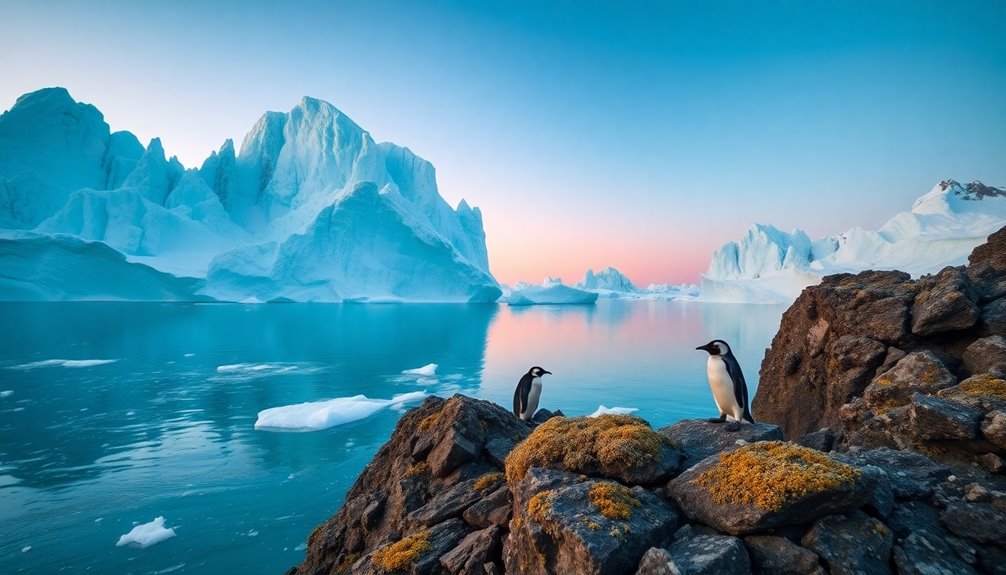
How can you make your journey to Antarctica more sustainable? One effective way is by choosing carbon offset programs.
These programs allow you to compensate for the carbon emissions produced by your flights and activities by investing in initiatives like reforestation and renewable energy. Since a round-trip flight to Antarctica can generate around 4.14 tons of CO2 per tourist, participating in these programs is crucial for minimizing your ecological footprint.
Look for tour operators that offer verified carbon offset options, as this aligns your travels with climate action and environmental stewardship. By contributing to these projects, you're not only helping combat the climate crisis but also playing a part in preserving the pristine ecosystems of Antarctica for future generations.
Community-led Conservation Projects
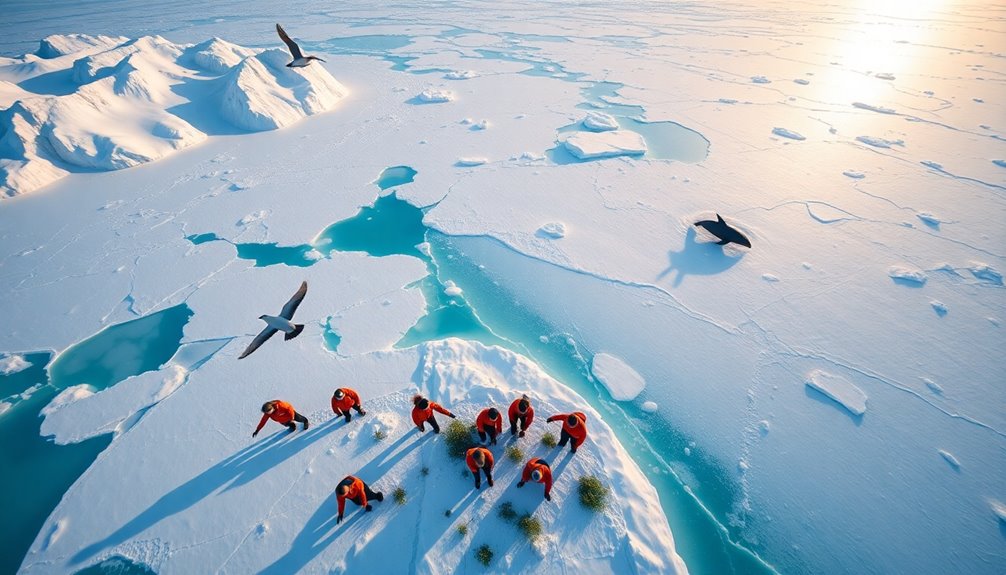
When you explore community-led conservation projects in Antarctica, you'll see how local efforts complement government and NGO initiatives.
These collaborations not only focus on preserving biodiversity but also promote cultural sustainability among the communities involved.
Government and NGO Efforts
In Antarctica, community-led conservation projects play a crucial role in preserving the region's unique ecosystems. Local researchers and NGOs work together, tackling the challenges posed by increased tourist activity.
These initiatives focus on habitat restoration and education, ensuring that native species thrive.
- The White Desert Earth Foundation allocates one percent of travel revenue to environmental projects.
- Educational outreach programs raise awareness about climate change impacts.
- Governments collaborate with NGOs to enforce adaptive management strategies.
- Regulations limit tourist numbers in ecologically sensitive areas.
Community and Cultural Sustainability
Although many might think of Antarctica as an isolated wilderness, community-led conservation projects demonstrate the power of collaboration in protecting its fragile ecosystems.
Initiatives like the White Desert Earth Foundation engage local communities in seagrass replantation, supporting biodiversity and marine conservation. These efforts not only empower the community but also promote sustainable tourism practices, ensuring that visitors understand their role in preserving this unique environment.
Educational outreach programs raise awareness about Antarctica's ecological significance, encouraging responsible tourism and environmental stewardship.
By partnering with conservation organizations, local stakeholders actively contribute to habitat restoration, enhancing the Antarctic ecosystem's resilience against climate change and increasing tourist activity.
Together, these projects illustrate how community involvement is vital for effective conservation in this pristine wilderness.
Optimal Months for Eco-Travel
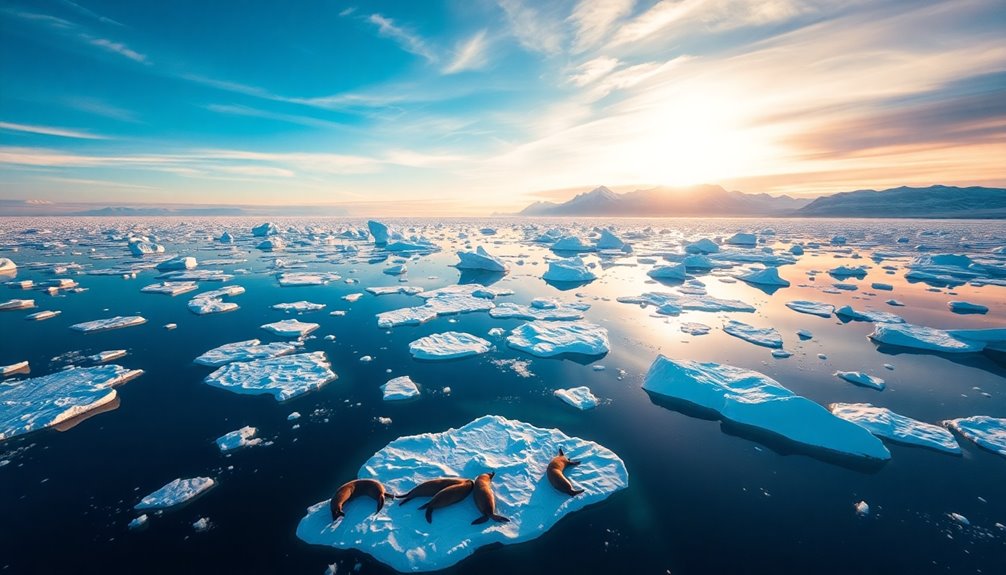
If you're planning an eco-trip to Antarctica, December to March is your prime window.
During these months, wildlife activity peaks, with penguins breeding and seals giving birth, all while the seasonal ice melt reveals stunning vistas.
Catching these natural wonders at their best makes for an unforgettable adventure.
Best Months for Wildlife Viewing
For those eager to experience the breathtaking wildlife of Antarctica, the best months for viewing stretch from December to March, when the austral summer brings milder temperatures and heightened animal activity.
During this period, you'll have the chance to witness the untouched wilderness come alive with vibrant life.
- December: Spot adorable Emperor Penguin chicks hatching.
- January: Observe seals and whales returning to feed in nutrient-rich waters.
- February: Watch nesting seabirds, including albatrosses and petrels, engaged in courtship displays.
- March: Experience the stunning migration of whales heading north after feeding.
These months offer unparalleled opportunities for wildlife viewing, making your Antarctic adventure truly unforgettable!
Seasonal Ice Melt Patterns
As the summer sun warms the Antarctic landscape from December to March, the seasonal ice melt reveals stunning transformations that underscore the region's vulnerability to climate change.
January emerges as the optimal month for eco-travel, offering the warmest temperatures and stable weather, perfect for witnessing the dramatic effects of ice melt.
During this peak season, you can explore the Antarctic Peninsula, where satellite data indicates nearly 40% reduction in ice extent over recent decades.
Engage in guided tours that not only showcase the untouched beauty of glaciers and icebergs but also educate you about climate impacts.
How to Make Your Trip More Sustainable
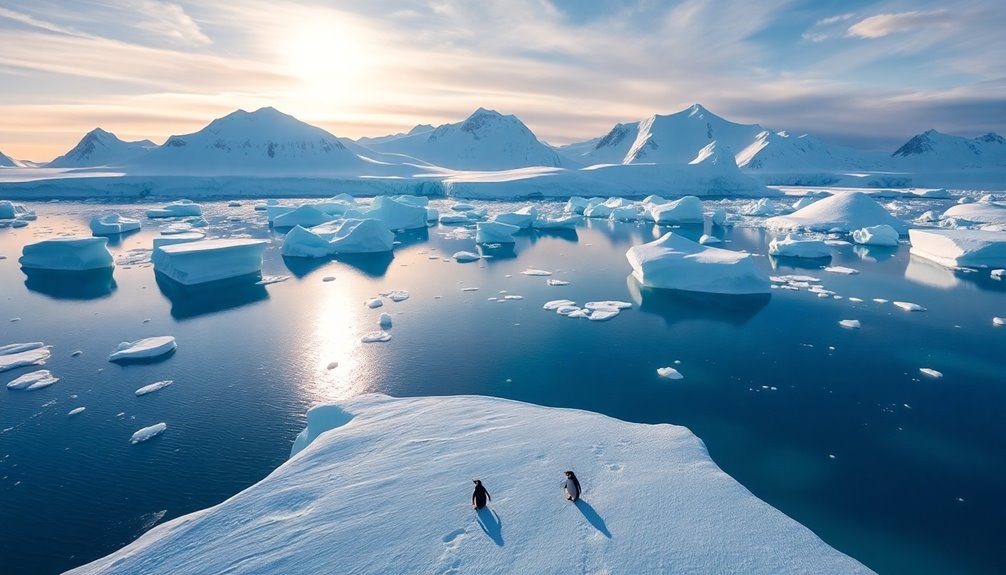
To make your trip to Antarctica more sustainable, start by using biodegradable toiletries and supplies that won't harm the environment.
When capturing wildlife moments, follow photography guidelines that respect animals' natural behaviors and habitats.
Biodegradable Toiletries and Supplies
While exploring the breathtaking landscapes of Antarctica, opting for biodegradable toiletries and supplies can significantly lessen your environmental footprint.
By choosing products that break down naturally, you help protect the pristine ecosystem. Here are some eco-friendly practices to consider:
- Biodegradable soaps and shampoos that leave no harmful residues
- Plant-based biodegradable wet wipes for personal hygiene
- Reusable containers for liquids and solids to avoid single-use plastics
- Eco-friendly sunscreen and insect repellent free from harmful chemicals
- Using biodegradable products also aligns with sustainable practices that can reduce reliance on non-renewable energy.
Wildlife-Friendly Photography Guidelines
Capturing the stunning wildlife of Antarctica can be an unforgettable experience, but it's essential to prioritize the well-being of the creatures you're photographing. Follow these wildlife-friendly photography guidelines to ensure a sustainable trip:
| Guideline | Why It Matters |
|---|---|
| Maintain 5 meters distance | Protects wildlife from stress and disturbance |
| Use a zoom lens | Keeps you at a safe distance for safety |
| Avoid flash photography | Prevents startling animals during crucial moments |
| Limit noise levels | Reduces stress and allows natural behaviors |
| Join guided tours | Learn ethical practices and respect regulations |
Frequently Asked Questions
How Sustainable Is Tourism in Antarctica?
Tourism in Antarctica isn't very sustainable right now.
With over 100,000 visitors annually, the environmental impact is significant, as increased foot traffic disrupts fragile ecosystems.
You're contributing to high CO2 emissions through long flights and cruises.
Plus, invasive species can hitch a ride on your clothing, threatening local biodiversity.
While some companies are working to reduce their footprint, the absence of binding regulations makes it tough to truly protect this pristine environment.
Why Is Antarctica Not Allowed to Be Visited?
Antarctica's like a precious jewel, cloaked in ice and mystery, demanding respect and protection.
You're not allowed to visit freely because the continent's fragile ecosystem can't withstand the weight of human footprints.
The Antarctic Treaty System and strict environmental protocols ensure that scientific research and wildlife thrive undisturbed.
How Is Antarctica Sustainable?
Antarctica's sustainability comes from strict regulations and eco-conscious practices.
You'll find that tour operators follow guidelines to reduce environmental impact, implementing waste management systems and carbon offset programs. They limit visitor numbers in sensitive areas and promote ethical wildlife viewing.
By collaborating with scientific organizations, they also support habitat restoration and raise awareness about climate change.
This collective effort helps preserve Antarctica's unique ecosystem for future generations while allowing you to explore its wonders responsibly.
Is Traveling to Antarctica Environmentally Defensible?
Traveling to Antarctica feels like stepping into a pristine, untouched realm, yet it comes with a heavy environmental cost.
You might revel in stunning icebergs, but each trip contributes over four tons of CO2—equal to an average person's yearly emissions.
With over 100,000 tourists annually, fragile ecosystems face real threats.
If you're passionate about nature, consider whether your adventure justifies the ecological price tag.
It's a beautiful world; let's keep it that way.
Conclusion
As you embark on your Antarctic adventure, remember that every small action counts. By choosing sustainable travel options and supporting local conservation efforts, you're not just a visitor; you're a steward of this pristine paradise. Like the delicate balance of the ecosystem, your choices can tip the scales toward preservation. So, pack your sense of responsibility along with your camera, and leave only footprints while capturing the breathtaking beauty of this untouched wonderland.

